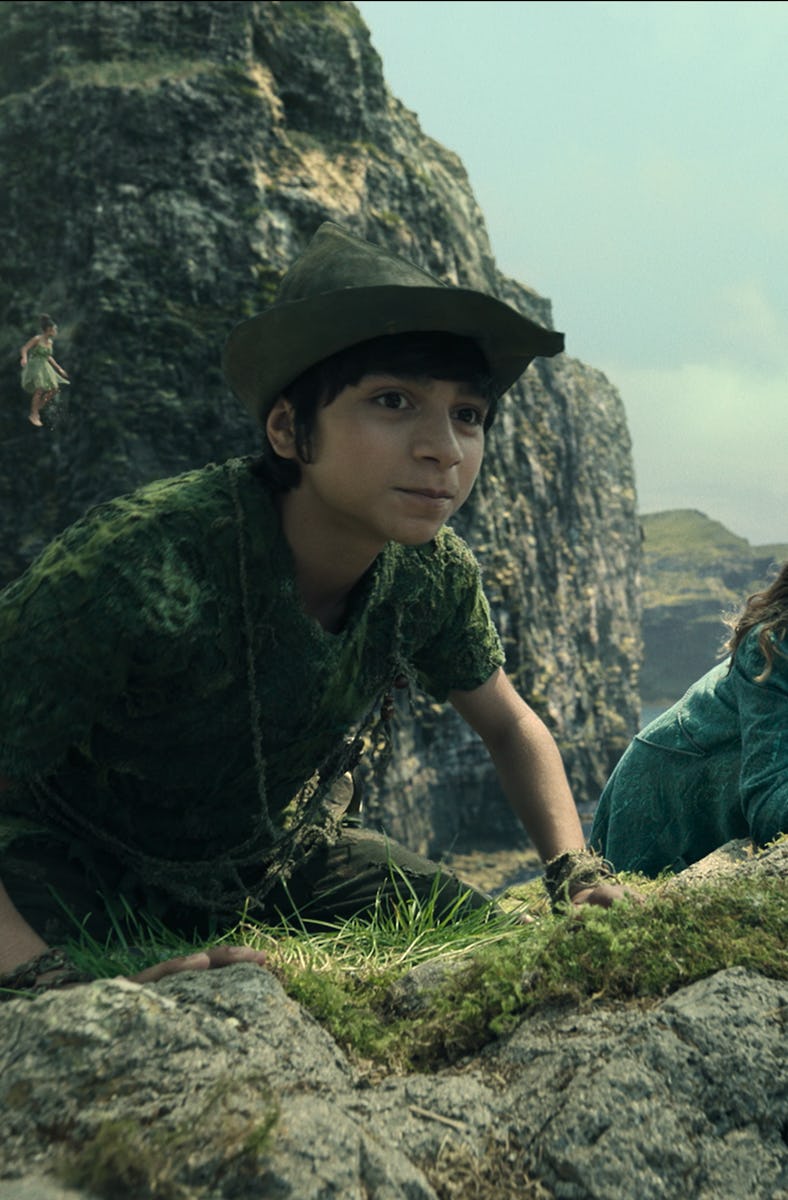Peter Pan & Wendy Lands With a Thud
David Lowery’s remake of the fairy tale classic could’ve used a little pixie dust.

Finally, a live-action remake of Peter and Wendy that does service to the beloved J.M. Barrie play’s wistful, whimsical nature, while giving its co-lead Wendy the agency she deserves, along with a culturally authentic update on the play’s more troublingly stereotypical elements. But enough about the 2003 P.J. Hogan film Peter Pan, which turned the timeless story into a yearning, melancholic tale of coming-of-age and the pangs of first love. What about David Lowery’s Peter Pan & Wendy, which promises to do all those things, with the surreal touch befitting the director of The Green Knight and A Ghost Story? Unfortunately, not so much.
Taking its title from the J.M. Barrie play that would form the foundation for the Peter Pan fairy tale, Peter Pan & Wendy follows Wendy Darling (Ever Anderson), an imaginative girl living in early 20th century London with her strict father (Alan Tudyk), gentle mother (Molly Parker), and two little brothers (Joshua Pickering and Jacobi Jupe). But on the night before Wendy is about to be sent to boarding school, a strange boy comes knocking at the children’s window. It’s Peter Pan (Alexander Molony, terribly wooden in his film debut), looking for his shadow — and waiting to take Wendy to Neverland. So the story begins, and plays out just as we expect, with a few choice differences: Peter and his embittered archnemesis Captain Hook (a deliciously game Jude Law) have a dark, heartbreaking past, Wendy is a bullish young girl who curiously interrogates that strange line between girlhood and womanhood, and Tiger Lily gets dialogue! But these are all vague attempts at adding a grain of realism to the iconic story, and in the end, those attempts end up fading into a pixie dust-addled haze.
Yara Shahidi as Tinker Bell in Peter Pan & Wendy.
Peter Pan & Wendy is less an exciting new update on a timeless story than it is a tired, mechanical rehash of iconography based on a forgotten Disney movie. Lowery, for what it’s worth, does attempt to give Peter Pan some depth with the thornier character dynamics and his trademark ethereal directorial flairs, but Peter Pan & Wendy ends up coming off a listless attempt to recapture a magic that was never there to begin with.
Because as well-known as the story is, let’s not beat around the bush: Disney’s 1953 animated Peter Pan is not a universally beloved classic. At the time, it may have been praised for its swashbuckling charm and vibrant Technicolor animation, but as The Chicago Tribune wrote, “the backgrounds are delightfully picturesque, the music only so-so.” Peter Pan may be better remembered for its iconography — Tinker Bell with her glowing pinup get-up, Peter and his forest-green cap, Wendy and her periwinkle blue nightgown — or for its troubling depiction of Native Americans (that was even a little too racist for the ‘50s) than anything else. It was a relic of the past that was due an update, and was effectively a blank slate for a promising auteur to go ham. But Lowery holds himself back with Peter Pan & Wendy, relying instead on the arthouse techniques he’s acclaimed for — the dreamy, sun-dappled, Malickian flashes of a life unlived, soaring vistas of an untouched countryside, beautiful bokeh close-ups of characters’ beatific faces — to elevate his and Toby Halbrooks’ half-baked script. Instead, these brief glimpses of real directorial vision only serve to remind of when Lowery did it better in The Green Knight.
Ever Anderson is perfectly fine, but underserved as Wendy.
It’s a real shame, because there are the bones of something good in Peter Pan & Wendy. The revelation that Peter and Captain Hook were once best friends before Hook “grew up wrong” feels like a game-changing twist on the classic story — Peter is in the wrong! Hook has an air of tragedy! But Peter Pan & Wendy doesn’t have the skill, or maybe the interest, in following this up, instead ending on a climactic duel between the two enemies where Peter offers an apology and forgiveness — immediately zapping it of its stakes. It also isn’t helped that Alexander Molony, as the perpetually friendly and blank-faced Peter, lacks any of the twinkling charisma or gravitas that this part demands, his cardboard-dry performance crumbling in the face of Law’s scenery-chewing Hook.
But if Peter Pan & Wendy stumbles with Peter, what about Wendy? Ever Anderson’s performance is perfectly serviceable as the more active Wendy, but again, we’ve seen this kind of action-ready Wendy before. There are sparks of something interesting in her Wendy — she’s childish and occasionally cruel, but intensely curious about womanhood — but Peter Pan & Wendy never follows through with it.
That may be where the problem lies in this movie: it’s all set-up towards something more interesting. Peter and Wendy are icons of pop culture, so the film attempts to turn them into real, deeply flawed human beings. But it does nothing with that, and instead just chooses to follow through the same beats of the classic story. And in trying to inject that realism into the movie, Peter Pan & Wendy loses that quiet wistfulness of the original play — the regret and sadness that comes with Peter’s choice of never growing up, and with Wendy’s choice to leave Neverland behind. To be fair, few film or TV adaptations have been able to capture that feeling of yearning for a life that one has knowingly, and willingly, given up. But ah — to live with the idea of a David Lowery Peter Pan that could’ve done so — that would be an awfully big adventure!